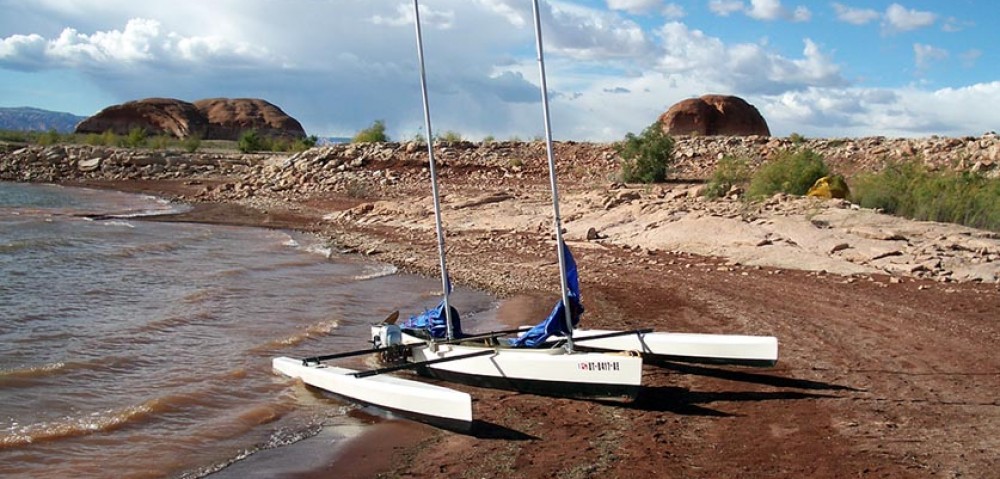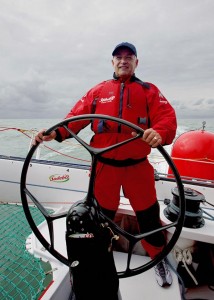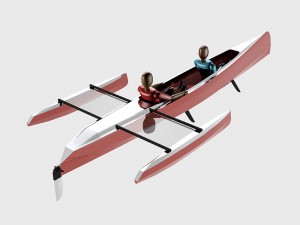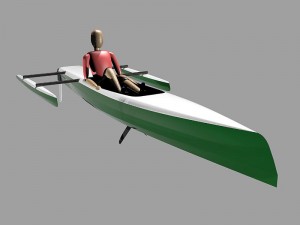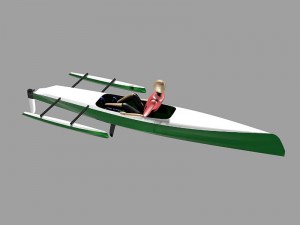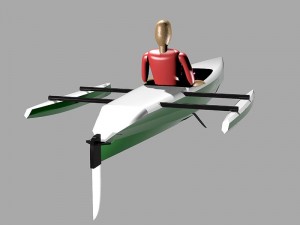| I grew up just a couple of miles from the Palos Verdes Peninsula along the coast of Los Angeles County and would often snorkel in those waters for abalone and lobsters with a group of my friends. One of the first “boats” I ever worked on, a leaky, 12′ paddleboard rescued from the heap out behind the main Lifeguard station in Redondo Beach, was used to explore the area with my buddies. Later, we cobbled together a catamaran of our own making by screwing together two of the paddleboards down on the beach and paddling both of them out to our favorite dive and play area.Guarding the northernmost entrance to Lunada Bay is Rocky Point. The waters around Rocky Point, which is the northern limit of the famous big wave riding area known as Lunada Bay, can be anything from totally benign and calm, to a full tilt, out of control melee of oceanic surges and thundering waves. When I started to design boats, I instinctively drew upon locations from my boyhood watery exploits and the name for this sea kayak, Rocky Point, came from this familiarity.
The Rocky Point is designed as a very fast, no-nonsense expedition touring boat with the capacity to carry the necessary gear and stores for an extended stay away from civilization. Obviously, with its narrow beam, this is not a beginner’s boat. Experienced paddlers, though, will settle-in quickly to its gently lessened stability and be able to make the most of the very small frontal area and very long waterline. The prismatic coefficient of the hull is set to .55 which will allow the paddler to reach and hold a very fast cruising speed. The boat should be equipped with an expedition class rudder to provide a gentle assist in turning as the hull has reduced rocker from my other sea kayak designs and turning was considered a skill for the advanced paddler for whom the boat was created.. Specifications
The prismatic coefficient of the hull is set to .55 which will allow the paddler to reach and hold a very fast cruising speed. The boat should be equipped with an expedition class rudder to provide a gentle assist in turning as the hull has reduced rocker from my other sea kayak designs and turning was considered a skill for the advanced paddler for whom the boat was created..
Just about all of my sea kayaks are designed with what I refer to as “a modified barrel back” stern. Not only do I wish to set my kayak designs apart from the everyday Greenland style craft, but I wanted to reduce the windage signature for the entire boat. My take on the Barrel Back form comes from the Art Deco inspired speedboats of the 20’s and 30’s, a very creative era in boating which continues to inspire me. The construction method is via stitch and glue technique from a 3mm marine plywood. The boat is glass/epoxy inside and out. The builder can choose to do a carbon or Kevlar layup inside with durable S-glass on the exterior for a rugged, easily repaired hull that is quite stiff and light. Standard layup in glass should yield a boat that is under 50 lbs. complete. Use of exotic laminate cloth will reduce the overall weight while making the boat a lot stiffer.
This is not an all-out racing machine. Instead, it is a very fast sea kayak in the racing boat style with its lowered aft deck, minimal foredeck height, maximized waterline for length and a hull shaped for performance. It is intended for experienced paddlers who want to really stretch it out and can maintain a fast clip on the water while carrying enough gear for a weekend trip. The kind of paddler for whom this boat is intended might want to explore the potential the Rocky Point has in a long distance paddling race and I expect that the boat will give an excellent showing against other, race specific designs…. and if the paddler were at a truly thuggish fitness level, this boat just might be able to steal away a victory. I’d love to see that. Chris Ostlind
|
Category Archives: Paddled Boats
NAGARE 21′ AND 17′ MIRAGE DRIVE SPEEDSTERS
Making use of Mirage Drive propulsion with more efficient hulls designs
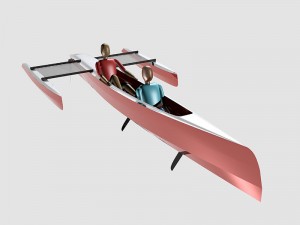
Nagare (nah-ga-ray) is a Japanese word meaning Flow.
The two boats in this group are 17 and 21 feet in length and are known simply as the Nagare 17 and the Nagare 21. Both designs make use of the popular Hobie Mirage drive for principal propulsion with the 21 footer 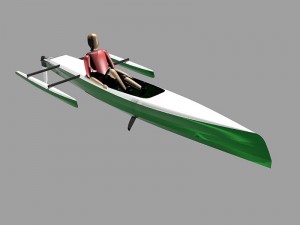 being a double Mirage setup and the 17relying on a single Mirage.
being a double Mirage setup and the 17relying on a single Mirage.
Both of them are configured as trimarans with fairly small and unobtrusive amas designed to give the boats remarkable stability in a wide range of conditions while allowing the vaka, (main) hull to be decidely slender for more effective drive through the water.
The Nagare sisters also have incredibly narrow waterline beam numbers that, when coupled with their fairly long hulls provide for very easily driven hull forms for high efficiency per unit of energy applied.
I expect both boats to operate at the very high end of commercially available paddled boats of the same length, beam and weight. So, yes, they can go pretty quickly, but that’s not the real purpose.
The real benefit of the design genre is through the ease with which they are propelled at any given speed, compared to other boats of their size. This efficiency translates directly to those using the boats as less tiring for miles covered, or greater speed with the same effort as other, wider designs.
Because the propulsion is derived from the largest muscles in your body, the leg muscles, rather than the arms and shoulders, there will be less fatigue for each mile traveled. Because leg muscles are so much bigger than arms, they will be able to do more work in a given period of time, making for longer possible trips, as well as the mentioned lower fatigue issue. With a less fatiguing effort, more people will be able to enjoy the experience of being out on the water for daylong adventures.
NAGARE 21 DOUBLE
SPEED AND STABILITY FOR DOUBLE RECREATIONAL BOATERS
The Nagare 21 uses a set of amas, mounted on a pair of simple, anodized aluminum tubes with quick release snap buttons holding the sections together for easy disassembly for car-topping. If a trailer is used to transport the boat, the beam of the Nagare 21 falls well below trailer maximums, so nothing special needs to be done to take the boat to and from the water. Two Nagare 21’s can be trailered, or car-topped, by removing one of the amas and placing the main hulls close to one another on the racks, or trailer. The removed amas easily fit inside the hulls and they are ready to go. The whole affair on the rooftop is very much like a pair of sea kayak doubles. Because of the length, I would not mount a boat this big on any compact cars. You would be very likely to rip the rack right off the roof in strong side winds.
Steering is by means of a simple, flip-up style kayak rudder with control lines run through the hull to a convenient steering lever in the cockpit. I suggest the SeaLine SmartTrak rudder system (do a search for supplier), the P-41 Multi-purpose rudder from Onno Paddles http://www.onnopaddles.com/onnocomponents.htmland the Feathercraft rudder system for hardshell boats. http://www.feathercraft.com/accessories/rudders-hardshell.php These are really great rudder units and will give excellent steering control with minimum drag.
NAGARE 21 SOT OPTION
This boat can be built with a full cockpit tub so that it functions as a Sit-On-Top kayak with full drainage through the Mirage drive openings. Auxiliary drain ports are located in the tub for rapid removal of any water that comes in over the side of the hull. I suggest the SOT option for warm water users, with the more traditional kayak style, Sit-Inside hull form for those who will be using the boat in colder water, or more frequent inclement weather.
The SOT version has internal bulkheads for support of the SOT tub, along with the capability of adding a small circular deck plate for an additional watertight compartment in the cockpit that is perfect for small items, such as cameras, wallets, car keys, etc.
The SOT variation is an optional element to the base plans. If you wish to built it as an SOT, drop me an email at my regular email address and I’ll get back to you.
ROUGH WATER USE
This is not really a boat that is meant to go out in rougher conditions, such as those where a full-blown sea kayak might be right at home. It’s meant for quieter waters, such as lakes, bays, harbors and bigger rivers. It can take a session in 1 or 2 foot breaking surf, but I would not expose the boat to bigger waves, especially in a shore break scenario. You may find yourself out from the shore a bit when the wind comes up, producing steep, choppy waves. The basic Nagare 21 will handle this easily because only the cockpit will be exposed to swamping. The amas will keep the boat stable while you pedal to shore, or a quieter place on the water, where you can bail-out the boat and continue.
It is a perfect boat for sightseeing, bird watching, fishing, photography, and just simple, energy efficient cruising with near bomb-proof stability (you can stand up in the boat while out on the water without your partner coming completely unglued, for instance).
The Nagare 21 is a fast, comfortable and unique boat for a couple who like to get out on the water, but do not want to hassle with the business of capsize that is present in other types of boats, such as kayaks and even canoes.
NAGARE 17 SINGLE
A NEW STYLE OF SOLO BOAT FOR TROLLING FISHERMEN
The solo version of the Nagare series has some very different twists, compared to its bigger sister. It has the same, highly efficient and easily driven, slender hull technology, the same set of trimaran style amas well aft for big time stability, the same generous cockpit opening and the same convenient utility for car-topping or lightweight trailering.
The design elements that set this particular boat apart from its sister craft is that the Nagare 17 has a very special capability when it comes to fishing.
AFT FACING TROLLING
Anybody who builds the Nagare 17 and intends to use it for fishing will probably be knocked-out by the potential for facing aft while trolling. Imagine using your legs to quietly drive the boat forward while you casually set trolling rigs, eat a sandwich and keep an eye on the fish finder… all while keeping an eye on the rigs you have set, with them easily at hand?
This is the signature utility development with the Nagare 17, designed specifically, for fishermen. It works like this…
The fisherman loads his boat, drops into the forward facing seat, hits the iPod for his favorite tunes and jams out across the lake at a remarkable speed for a human powered boat. He zips across the lake in virtual silence because he’s driving a very skinny and efficient hull with no engine sounds. Once he arrives, he’s going to make a few sneaky trolling passes with his Mirage drive pushing him along over that monster crew of Pike that are hanging around on their favorite piece of structure. Wham! Fish On! and the day starts with smile on his face.
If you’ve ever fished from a typical Sit-On-Top, you know that you have to face forward while trying to look over your shoulder while trolling. Hook-up and then you have to swivel around, grab the rod and go after the fish. All the time you are doing this, you have to balance the boat carefully, because the whole tamale could go over and end your day right then and there.
Well, that’s how you used to do it, anyway.
With the Nagare 17, you can take it to a whole new level of fishing pleasure. The Nagare 17 is equipped with twin Mirage drive trunks. When driving the boat forward and facing forward, the Mirage drive is dropped into the forward trunk and a tractor-style seat is dropped into the aft trunk with the seat bottom resting on the top of the trunk.
To convert the boat to aft facing trolling and fishing, you simply stand up in the boat and swap the Mirage drive for the aft mounted seat plug and the seat then goes to the front trunk… facing aft. With the Mirage drive still set to drive the boat forward, you simply sit down and start pedaling, slowly, up to your desired trolling speed.
Now, you can watch your fish finder, GPS and your trolling rigs while you continue to tool along at your favorite speed for nabbing the fish. Get one on and simply work that rod while continuing to face aft. No twisting around in your seat, no ”just about dumped it” scenarios, just simple, fun fishing in a very stable boat. What could be cooler than that?
With the fore/aft balance point of the boat set right between the two drive trunks, there is but a very minimal change to boat pitch when you change the direction you face.
The Nagare 17 is further designed to accept an insulated and watertight tank between the two aka tubes where they run through the aft deck. You can use this for all kinds of stuff like: your catch, fresh bait storage, cold beverages if you catch and release… whatever suits your needs. There is plenty of room between the two drive trunks for a pretty good sized tackle box and lots of room up forward of the trunks for any of that “other stuff” that fishermen seem to sneak aboard their boats.
A moveable electronics unit can be fastened at the forward end of the cockpit, or unhooked and moved around aft if you’d rather have it facing that way.
Maybe you want to cast lures or flies instead of troll. The boat is so stable with the two, wide set amas, that you can stand up and cast all day without ever feeling like you are getting the least bit tippy. All in all, the Nagare 17 is quite a boat for fishing, as well as just plain fun, recreational pursuits.
The Nagare sisters represent a unique design family for human powered vessels. They are quick, stable and with their unique styling, represent a distinct departure from the looks of traditional boats one typically sees on any given shore or launch ramp. Both boats are designed to be built in marine ply Stitch and Glue methods for the hull sections, with cedar stripped decks to take advantage of the really beautiful, smooth curves capable from that style of building. You can paint the lower sections of the hull and leave the cedar decks natural with a deep varnished finshed, for a real knock-out boat that will really gather a crowd.If you really want to have a plywood deck build instead of the cedar strip build, write and twist my arm gently. I can design that change for those who really like to build that way
Plans are not yet complete, so if you would like to build one of these two boats, please send me an email and I’ll put your name on the mailing list for information, or watch the plans section of Duckworks for the notice.
